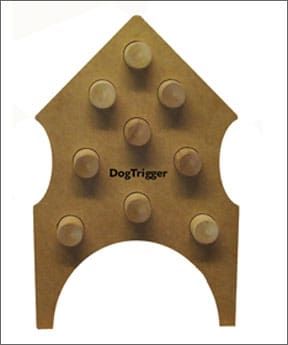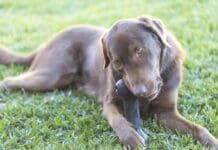Only rarely does a totally new genre of dog toy appear on the market, and it almost never happens that a new genre of toys is introduced with more than just one or two representative products.
This rare event was recently engineered by Sweden’s Nina Ottosson, with the introduction of her Zoo Active Games, a line of 10 novel interactive dog toys (and a few cat toys!). As a huge fan of interactive toys for dogs, I was eager to get my paws on as many of the toys as I could, and see if they were as fun for dogs as they looked!
The Zoo Active toys are available in the United States from only a select few distributors, including Paw Lickers Bakery and Boutique, owned and operated by Marianne Gage and her son David in Greenfield Center, New York. Fortunately for me, when Whole Dog Journal editor Nancy Kerns contacted David to inquire whether we could test the toys, he generously offered to send me seven of the products to try out. I’ve been introducing the toys to my own dogs for a few months, so I knew they had great “fun potential,” and looked forward to an opportunity to try them out on a bunch of other dogs, too.

The human participants in our Paw Lickers Puzzle Party and Test had a blast watching and helping the dogs solve the puzzles, and comparing how the different dogs approached each task.
So it was with great anticipation that I planned a Paw Lickers Puzzle Party, inviting friends to bring their dogs to test and review the intriguing interactive puzzle toys.
The night of the party finally arrived. We had seven toys to test, and seven canine players came, so we set the dogs up around the room. We also set up dividers between them to reduce distractions and the potential for resource-guarding. Each of the dogs was accompanied by an owner/handler, and we had four trainer/observers taking notes on the dogs’ interactions with the toys. We allowed each team 10 minutes per puzzle, then passed each toy to the next dog in line. If a dog emptied the toy quickly, it was reloaded so the dog could continue to play.

The Dog Tornado
Pieces of the puzzle
With one exception, the Zoo Active puzzles are made of wood and particle board and didn’t look like they’d stand up to heavy abuse. It is clear they are intended to be interactive – not to be left for dogs to play with them unattended. I was curious to see how they’d hold up to normal, supervised abuse.
By the end of our puzzle party, there was unanimous agreement that a good time was had by all. Five of the seven puzzles won several canine and human fans; one (the “Dog Trigger”) had some logistical problems but was workable, and only one (the “Dog Box”) was judged by all present to be a “dud.”

Willow used as much of her anatomy as was needed to empty treats from the Dog Tornado. She also figuredout the “pattern” to the puzzle.
-
- I had invited friends with a variety of breeds, of different ages and sizes, to give the toys a thorough test. All the owner/handlers and observers were Peaceable Paws Academy graduates and/or trainers that I knew well. They were instructed to help their dogs as much as they felt the dogs needed to be successful with the toys. The partygoers were:
- Gretel, a young adult spayed female German Shepherd-mix, and her owner/handler James Latonick of Martinsburg, West Virginia.
- Merlin, a senior neutered male Jack Russell Terrier, and his owner/handler Karin Fellers of Harpers Ferry, West Virginia.
- Molly, a senior spayed female Cocker Spaniel, and her owner/handler Katie Ervin of Hagerstown, Maryland.
- Willow, an adult spayed female Collie/Shepherd-mix, and her owner/handler Penelope Brown of Washington, D.C.
- Truman, an adolescent neutered male Golden Retriever, and his owner/handler Beth Adamec of Windsor Mill, Maryland.
- Allie, a senior spayed female Golden Retriever, and her owner/handler Susan McCullough of Vienna, Virginia.
- Jamie, a senior spayed female Border Collie-mix, and her owner/handler Roz Ferber of Alexandria, Virginia.
Our observers were: Shirley Greenlief of Martinsburg, West Virginia; Jeanne Klink of Meyersdale, Pennsylvania; Hedda Garland of Washington, D.C.; and Tim Sandusky of Silver Spring, Maryland.

Merlin used his paws on the Dog Smart, but most dogs had more success removing the pegs with their mouths.
Our results
Here are the toys themselves, and the results of our testing party, in order of highest (four paws) rated to lowest (zero paws):
The Dog Tornado ($46) consists of four layered discs, three of which have round slots for treat placement (the fourth is the “lid”). The human places treats in all the slots, rotates the layers to hide the treats and lets the dog begin; you can show the dog a treat in the slot to get him started if necessary. The dog moves the layers with his or her paws and nose to reveal – and eat – the treats.
All the dogs figured this one out and emptied the Dog Tornado of treats within five to six minutes. Jamie required a little help at first; this was her first toy, so she wasn’t sure what was going on, plus, in general, she seemed to offer less behavior with the toys (thus needing more help) than the other dogs.
The other dogs varied in technique. Truman used lots of enthusiastic foot action. Allie loved it, and moved it across the room with her energetic efforts. Merlin bit it and flipped it upside down.
An owner comment from Penelope Brown: “The Dog Tornado was fantastic. Willow used everything – paws, nose, and chin. She even figured out that when one hole on a layer was open, the opposite one was also.”
The Dog Smart ($42) is a disc with eight round slots around the perimeter and one in the center, looking somewhat like the face of a clock. A hollow round peg sets in each slot, with a treat hidden underneath. The dog must pick up the pegs with his mouth or dislodge them with nose or paws to gain access to the treats.
This one was also a favorite of most of the dogs and humans. It was a little harder than the Tornado, and some of the dogs eventually lost interest. After five minutes of effort yielded only two treats, Allie began offering other behaviors to Susan in hopes of earning rewards. In contrast, Gretel found all nine treats in two minutes, and when James placed the pegs back without treats, Gretel continued to remove them. Willow also enjoyed the toy even after the treats were gone; she continued to play with the pegs, and even replaced some of them in the slots herself!

The Dog Pyramid
James Latonick’s comment: “Gretel’s favorite toy of the evening was the Dog Smart. She loved taking the pegs in her mouth, and caught on to this game fast.”
The Dog Pyramid ($22) is the only one of the seven toys we tested that wasn’t made of wood, but rather of sturdy, bright red plastic. Shaped like a beehive with a weighted bottom and one hole on the side near the top, the toy is intended to be loaded with treats and pushed around by the dog to make the treats fall out. It’s similar to other treat-stuffed toys such as the Buster Cube and Molecuball, but the weighted bottom makes it unique; every time the dog pushes it over, it rights itself again.
This one was very popular with our party crowd as well. It was Allie’s favorite, and Truman had so much fun with it he batted it across the room. Gretel, on the other hand, only got one treat out in three minutes and lost interest due to the low payoff, and Jamie got bored with the toy after getting a few treats out and deciding they were too low-value to be worth her attention. (As a treat dispensing toy, the Pyramid was loaded with dry kibble, as moist treats would stick to the inside.) Willow, creative as always, not only pushed it around vigorously, but also picked it up in her mouth and shook it to make the goodies fall out.

The Dog Spinny
Susan McCullough’s comment: “Allie stayed with the Dog Pyramid for the full ten minutes. The rolling motion of the toy seemed to fascinate her as much as the treats she was able to ferret out. This toy definitely seemed to be her favorite.”
The Dog Spinny ($37) is a simpler version of the Tornado – a flat disc with only one layer for treat placement (plus the lid). The dog must spin the lid to find the eight treats underneath. All the dogs emptied the Spinny easily – but none of the humans enjoyed it much. The Tornado was just as much fun but more of a challenge for the dogs with its additional two layers.
Jamie found three of the treats within 10 seconds, and didn’t want to stop even when the Spinny was empty. Truman got very excited and worked extremely hard to get the treats – scratching, pushing, digging, and spinning the lid at a high rate of speed. Almost all the dogs emptied the toy within five minutes, and got a reload. Penelope Brown’s comment: “The Spinny was fun for Willow. She figured it all out; she spun the disc with her chin and paw, even experimented with picking it up and dropping it (on my broken finger – ouch!).”
The Dog Brick ($47) is a flat rectangle with four oblong cutouts, each of which has two round slots into which treats are placed (one on each end) and two square sliding pieces that cover the treats. The dog must move the squares to find the treats. This toy works best with paw or nose action; dogs whose behavior choice is biting were at a disadvantage.

The Dog Brick
The Brick had fewer devotees. It was the favorite puzzle of only one dog: Merlin, probably because the behavior options were more limited. Merlin was the most adept at manipulating the squares; he retrieved all eight treats within four minutes.
Gretel also did well, finding all the treats in six minutes with a little help from James. Molly lost interest and walked away after four minutes, but Katie encouraged her to come back and try again, and she eventually found seven of the treats. Willow got five treats in three minutes – and became much more motivated to look for the remaining ones when Penelope switched to a higher-value treat. Karin Fellers’ comment: “Merlin is a food hound and is relentless with the trash can at home, so this was really fun for him. He especially liked the Brick, where he could paw the sliding square to get the treats out.”
The Dog Trigger ($46) is a flat, arrow-shaped puzzle with semi-circles cut from each side and the bottom. There are nine holes for treats, with a round peg in each hole that protrudes from the front of the Trigger. The dog must push each peg with his nose or paw to make the treats fall out of the back of the trigger, and collect them from the floor through the bottom semi-circle. The side cut-outs are for the human to hold the trigger between her legs.
This toy has some design flaws. While the concept is interesting – and significantly different from most of the other puzzles – the execution is somewhat lacking. None of the dogs really figured this one out in the allotted 10 minutes; most of them failed to make the connection between pushing in the peg and finding the treat on the floor. Owners found it awkward to hold the Trigger between their legs, and dogs kept trying to go behind the toy and just eat the treats from the holes instead of pushing them out with the pegs.

Again, Merlin did well with this toy by using his paws. Dogs who mostly use their mouths grew quickly frustrated.
The Trigger has some potential, but would require more training for the dogs to understand the concept of “push the peg, find the treat on the floor.”
Roz Ferber’s comment: “The Trigger was somewhat awkward; it must be held, and Jamie didn’t notice the fallen treats.”
The Dog Box ($44) is a cube with a removable top, no bottom, and a square insert that slides in and rests at an angle, with two narrow strips of foam attached to the surface. One wall of the cube has a five-sided opening cut from the bottom.
There are three options for the top piece – one with a large hole, one with a smaller hole, and one with an oblong-shaped hole just slightly larger then the accompanying round peg. To get a treat, the dog is supposed to push the peg, and eventually pick it up and drop it through the top opening. Treats balanced on the foam strip them fall out the bottom cut-out for the dog to eat.
Neither the dogs nor their handlers liked this toy. It fell apart easily, and didn’t set the dogs up for success. Our testers tried to poke their noses through the top opening or the bottom cut-out for direct access to the treats; none of them were able to figure out the concept of pushing the peg into the hole to make treats fall out the bottom. Merlin had the most fun with it, as he enjoyed knocking the box around and sticking his head through the openings, but he didn’t have any more of a clue than any of the other dogs as to the intended goal for the toy.
Susan McCullough’s comment: “The Dog Box was a dud. Allie only wanted to stick her head in the hole to get the treat. When she couldn’t do that, she lost interest.”

Dog Trigger
General comments
• Beth Adamec: “I noticed that as we went from toy to toy Truman became increasingly excited to try the next thing.”
• Katie Ervin: “Molly and I had a lot of fun playing with the toys at the party. She especially liked the Dog Smart and the Tornado.”
• Roz Ferber: “Overall I like the toys, and think they will provide great stimulation for smart, bored dogs.”
• Karin Fellers: “Merlin got to the point where he was waiting for the next toy with anticipation. I think he liked them all.”
• James Latonick: “This was a fun exercise for us; we got to play with some cool toys! I think the particle board construction isn’t ideal for all the toys where exposure to moisture (dog spit) is certain to have a destructive effect over time.”
Puzzling conclusions
The Nina Ottosson puzzles are truly a new generation of interactive dog toy – unlike any I have seen before, and well-designed for today’s new generation of positively trained “thinking dog.” Most of the toys provided challenging and fun entertainment for our test dogs and their owners, some of whom left after the party with full intention of acquiring one or two of their favorites for their dogs to play with.
We did not explore any of the variations described in the instructions that are intended to make the toys even more challenging, such as placing the round pegs in various slots, thus requiring the dog to remove the peg before sliding other parts and exposing the treats. This would add another dimension of interest when the dog became so adept at the original puzzle that the challenge faded.
The toys are costly, to be sure, partly as a result of shipping from the European source. The particle board construction is somewhat of a concern, although after 90 minutes of concentrated dog-attention, none showed significant wear. Some of the pegs bore minor tooth marks from enthusiastic players, but nothing that would interfere with their function for the next round of play.
It’s important to remember that, with the exception of the Pyramid, the puzzles are only intended for use with the owner present and supervision; they are not “leave with your dog to play with while you’re away at work” toys. We also suggest making sure they are thoroughly air-dried after each use to minimize deterioration of the particle board from moisture.
That said, we enjoyed the toys immensely, and look forward to more hours of fun playing with them with our own dogs, perhaps to scheduling future Pawlicker Puzzle Parties. We’d like to pass along a last comment from Gretel’s human, James Latonick, and direct it to Nina Ottosson and the people at Paw Lickers Boutique and Bakery, “Thank you for a great time!”






